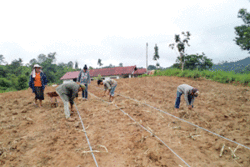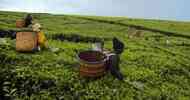Vientiane Times | 14 January 2015
Champassak moves towards ‘land as equity' project model
Champassak provincial authorities will move to promote investment projects that allow entrepreneurs and villagers to jointly hold shares in the ventures concerned, aiming to promote fairer projects that benefit villagers as well as investors.
Villagers could earn more income once they hold shares in investment projects.
Under this form of the project, local villagers will use their land plots as shares while the investors will provide the funding, technical expertise and marketing.
Importantly, the ‘land-as-equity' model will see local villagers retain the land ownership rights in the event that the venture falls over.
Under the land leasing arrangements proposed, the villagers will lease their land to the investor and retain their ownership rights but in return for providing the leased land they will receive a share of the profits made by the investors.
However if the investment project fails the land is supposed to revert to the ownership of the villagers.
The move comes after authorities found that the province and villagers did not benefit as much as anticipated from the concession projects undertaken in the past years, especially those such as rubber plantations.
Champassak provincial Governor, Dr Bounthong Divixay told Vientiane Timeson Tuesday that some investors did not intend to develop the projects granted by authorities as their intention was to sell the concession to other entrepreneurs.
“We want to operate ‘land-for-equity' types of project in our province because we believe that this kind of the project will help generate more income for local people,” he said.
The provincial authorities granted the first such kind of project to a Chinese entrepreneur, who will spend US$100 million (about 800 billion kip) on an agricultural development project in Phonthong district, for which a ground-breaking ceremony was held in October last year.
The project covers an area of 10,000 hectares and the project activities will include rice plantations, irrigation systems, livestock husbandry, fruit tree plantations and modern processing factories, aiming for export to East Asian countries including China.
Under the project, the Chinese company wil l build a modern rice mill with an installed capacity of 300,000 tonnes annually.
The Chinese company will hold 70 percent of the shares in the project and the rest belongs to local villagers.
Dr Bounthong said if villagers are employed by the project, they can earn more money from the project, not just from their share s.
In previous years, Champassak authorities mostly operated investment projects by granting land concessions to investors or authorising projects structured under the ‘3+2' or ‘4+1' models.
A ‘3+2' project means villagers provide the land and labour while investors provide funding, technical expertise and marketing while under the ‘4+1' approach, the villagers provide only the labour for the project and the rest belongs to investors.
However previous outcomes have shown that villagers did not gain much in the way of benefits from such kinds of projects.
Champassak moves towards ‘land as equity' project model
Champassak provincial authorities will move to promote investment projects that allow entrepreneurs and villagers to jointly hold shares in the ventures concerned, aiming to promote fairer projects that benefit villagers as well as investors.
Villagers could earn more income once they hold shares in investment projects.
Under this form of the project, local villagers will use their land plots as shares while the investors will provide the funding, technical expertise and marketing.
Importantly, the ‘land-as-equity' model will see local villagers retain the land ownership rights in the event that the venture falls over.
Under the land leasing arrangements proposed, the villagers will lease their land to the investor and retain their ownership rights but in return for providing the leased land they will receive a share of the profits made by the investors.
However if the investment project fails the land is supposed to revert to the ownership of the villagers.
The move comes after authorities found that the province and villagers did not benefit as much as anticipated from the concession projects undertaken in the past years, especially those such as rubber plantations.
Champassak provincial Governor, Dr Bounthong Divixay told Vientiane Timeson Tuesday that some investors did not intend to develop the projects granted by authorities as their intention was to sell the concession to other entrepreneurs.
“We want to operate ‘land-for-equity' types of project in our province because we believe that this kind of the project will help generate more income for local people,” he said.
The provincial authorities granted the first such kind of project to a Chinese entrepreneur, who will spend US$100 million (about 800 billion kip) on an agricultural development project in Phonthong district, for which a ground-breaking ceremony was held in October last year.
The project covers an area of 10,000 hectares and the project activities will include rice plantations, irrigation systems, livestock husbandry, fruit tree plantations and modern processing factories, aiming for export to East Asian countries including China.
Under the project, the Chinese company wil l build a modern rice mill with an installed capacity of 300,000 tonnes annually.
The Chinese company will hold 70 percent of the shares in the project and the rest belongs to local villagers.
Dr Bounthong said if villagers are employed by the project, they can earn more money from the project, not just from their share s.
In previous years, Champassak authorities mostly operated investment projects by granting land concessions to investors or authorising projects structured under the ‘3+2' or ‘4+1' models.
A ‘3+2' project means villagers provide the land and labour while investors provide funding, technical expertise and marketing while under the ‘4+1' approach, the villagers provide only the labour for the project and the rest belongs to investors.
However previous outcomes have shown that villagers did not gain much in the way of benefits from such kinds of projects.














